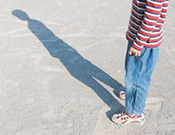|
|
 |
|
The views expressed on this page are soley
those of the author and do not
necessarily represent the views of County
News Online
|
 |
Start Talking!
Know! Social
anxiety increases substance abuse risk
9/6/2017
Many adults are known to drink alcohol at social functions to “loosen
up” and feel more comfortable interacting with others. Well, guess
what? Many of our teens are doing the exact same thing. It is often
referred to as “liquid courage” because, after a few drinks, a person
may no longer feel afraid to get out there and dance, to ask out a love
interest or to simply chat with their peers.
So then the question becomes: Is a person with social anxiety at a
higher risk for substance abuse? Absolutely. In fact, young people who
suffer with social anxiety disorder are at a greater risk for
developing depression by the age of 15 and engaging in substance abuse
by the age of 16 or 17.
It is very important, however, not to confuse normal teenage shyness
with social anxiety disorder. There are key differences. Being shy, by
one definition, is being reserved or having or showing nervousness or
timidity in the company of other people. This may be a teen walking
into a social gathering and feeling a little uneasy at first – not
unusual. Social anxiety disorder, on the other hand, would be a teen so
overwhelmed with nervousness and self-consciousness that he/she would
do everything they could to avoid going to that party.
Symptoms of social anxiety disorder, on average, begin to show around
the age of 13. However, some children as young as three or four are
known to display signs of this, sometimes debilitating, condition. It
may begin with a child trying to avoid being called on in class, not
because he or she doesn’t know the answer, but out of fear of having to
speak. As the anxiety builds, the child may pull away from friends and
drop out of the extracurricular activities that they once truly
enjoyed. School performance may take a sudden dive. Worse yet, the
child may try to avoid school altogether and may begin exhibiting signs
of depression. It is at this point where it becomes common for teens to
turn to alcohol and drink excessively to cope with or try to escape
from the symptoms – a temporary “fix” that, in the end, only adds to a
person’s depression, anxiety and irritability.
Social anxiety disorder is considered a “silent disorder” because, many
times, it will take years before a child is diagnosed, if ever. Due to
the nature of the disorder, these children avoid drawing attention to
themselves. They tend to be compliant at home and school and they
become very good at slipping into the background unnoticed.
What can parents do?
Parents play an essential role in identifying the signs and symptoms of
social anxiety disorder, and stepping in before the disorder gets out
of control. Experts from the Columbia University Medical Center share
the following questions to highlight some of the warning signs of
social anxiety disorder:
Is your child uncomfortable speaking to teachers or peers?
Does he or she avoid eye contact, mumble or speak quietly when
addressed by other people?
Does your son or daughter blush or tremble around other people?
Does your child worry excessively about doing or saying something
“stupid”?
Does your child complain of stomachaches and want to stay home from
school, field trips or parties?
Is he or she withdrawing from activities and wanting to spend more time
at home?
If you observe these signs in your child, he or she may have social
anxiety disorder, and may be at a greater risk for substance abuse. You
are encouraged to reach out to a doctor or mental health professional
to determine if a social anxiety disorder is present and, if so, he or
she can provide your child with healthy ways to manage and cope with
their disorder, leading to a much happier and more fulfilling road
ahead.
Learn how to get the conversation started at StartTalking.Ohio.Gov.
|
|
|
|

